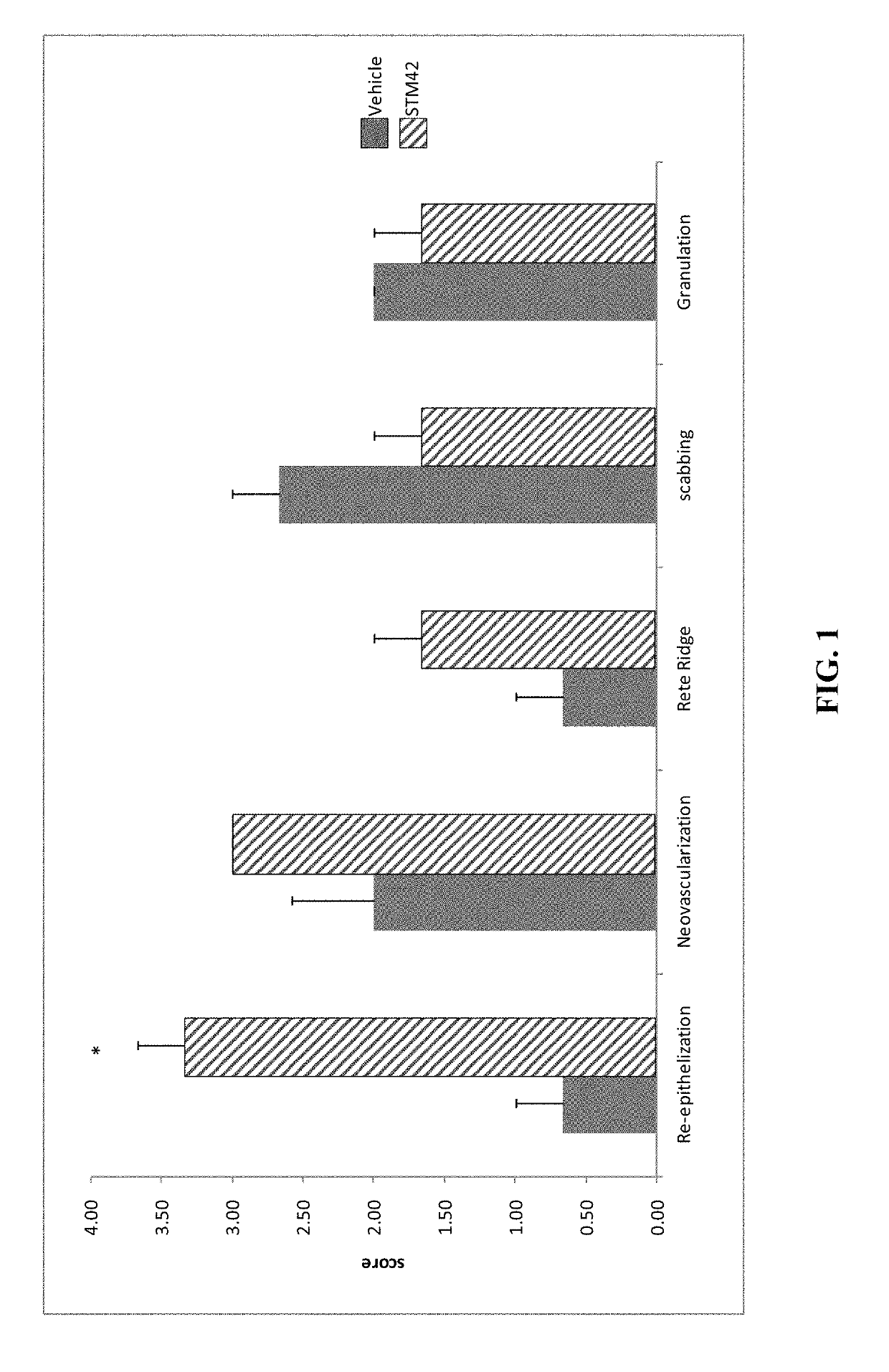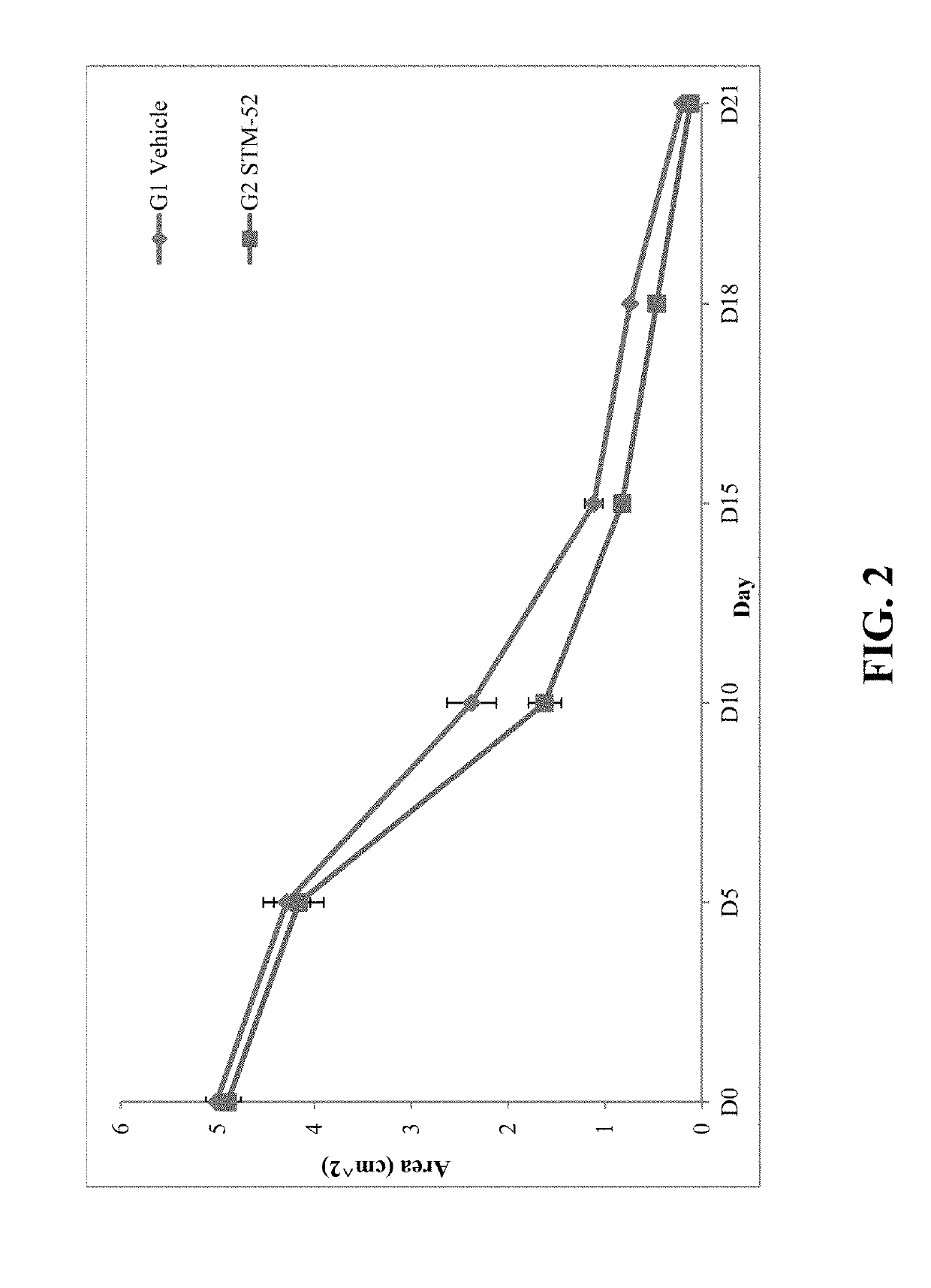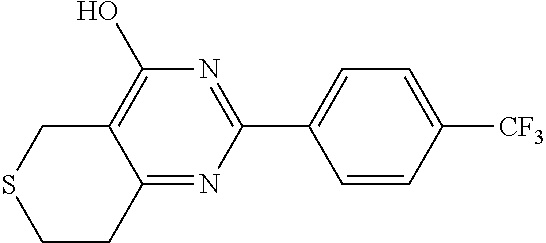Compositions and Methods for Wound Treatment
a composition and wound technology, applied in the field of compositions and methods for wound treatment, can solve the problems of loss of function, difficulty in normal adequate wound healing, and difficulty in treating pressure ulcers,
- Summary
- Abstract
- Description
- Claims
- Application Information
AI Technical Summary
Benefits of technology
Problems solved by technology
Method used
Image
Examples
example 1
ion of GO
[0047]
[0048]Although GO includes many carboxylic acid groups on its edges, the reactivity of these aromatic carboxylic acid groups is not high. To improve its linking efficiency with HA, some of these aromatic carboxylic acid groups on GO are converted to aliphatic aromatic carboxylic groups. See Scheme 1. In this step, some hydroxyl groups of GO are also converted to carboxylic groups (as illustrated above).
[0049]Graphene oxide (1.25 g, 250 mL of 5 mg / mL GO dispersion in de-ionized water; supplier: Goographene Inc.) was added to 250 mL of ultra-pure de-ionized water and stirred for 5 minutes. Sodium hydroxide pellets (3 g (0.075 moles; supplier: Sigma-Aldrich) were added in small solid portions to the mixture over 30 minutes. Once addition was complete, it was stirred for 1 hour at room temperature. Next the solution was ultrasonicated for 30 minutes, and then chloroacetic acid (3.54 g (0.0375 moles); supplier: Alfa Aesar) was added in small, solid portions over 20 minutes...
example 2
ation of HA
[0050]
[0051]The general procedure of derivatizing HA is shown in Scheme 2. Hyaluronic acid (100 mg, MW=10,000 (n=13.5 in the scheme), 0.00001 moles; supplier: Creativepegworks) in ultra-pure deionized water (20 mL) was stirred for 5 minutes at room temperature. 1-(3-Dimethylaminopropyl)-3-ethyl carbodiimide hydrochloride (EDC) (52 mg, 0.00027 moles, supplier: Alfa Aesar) was added to the mixture and stirred for 3 hours at room temperature. During this time, the pH of the solution was maintained at approximately 5 to 6 by small additions of 0.1N hydrochloric acid. This mixture was added dropwise to a separate mixture containing adipic dihydrazide (ADH) (17 mg, 0.00027 moles; supplier: Alfa Aesar) in 5 mL of ultra-pure deionized water at room temperature. Once the addition was complete, it was stirred at room temperature for 18 hours. The solution was then subjected to dialysis (MWC=3500) for 24 hours. The mixture was then lyophilized to obtain a white powder (100 mg). 1H N...
example 3
Between Modified GO and Derivatized HA to Prepare GO-HA Conjugate
[0052]The general procedure of preparing GO-HA is outlined in Scheme 3 below. The modified GO obtained in Example 1 (0.90 g) was added to ultra-pure deionized water (100 mL) and stirred for 5 minutes, followed by ultra-sonication for 15 minutes. 2-Succinimido-1,1,1,3-tetramethyluronium tetrafluoroborate (TSTU) (0.32 g, 0.001 moles; supplier: Alfa Aesar), 2-(1H-benzotriazol-1-yl)-1,1,3,3-tetramethyluronium hexafluorophosphate, Hexafluorophosphate Benzotriazole Tetramethyl Uronium (HBTU) (0.41 g, 0.001 moles; supplier: Aldrich) and diisopropylethyl amine (DIEA) (0.15 mL, 0.001 moles; supplier: Sigma-Aldrich) was added to the mixture at room temperature and stirred for 5 minutes. Then a solution of hyaluronic acid-adipic hydrazide (obtained from Example 2) (0.90 g in 150 mL of ultra-pure deionized water) was added dropwise to the activated graphene oxide solution at room temperature. The reaction mixture was allowed to st...
PUM
| Property | Measurement | Unit |
|---|---|---|
| molecular weight | aaaaa | aaaaa |
| solubility | aaaaa | aaaaa |
| number-averaged molecular weight | aaaaa | aaaaa |
Abstract
Description
Claims
Application Information
 Login to View More
Login to View More - R&D
- Intellectual Property
- Life Sciences
- Materials
- Tech Scout
- Unparalleled Data Quality
- Higher Quality Content
- 60% Fewer Hallucinations
Browse by: Latest US Patents, China's latest patents, Technical Efficacy Thesaurus, Application Domain, Technology Topic, Popular Technical Reports.
© 2025 PatSnap. All rights reserved.Legal|Privacy policy|Modern Slavery Act Transparency Statement|Sitemap|About US| Contact US: help@patsnap.com



